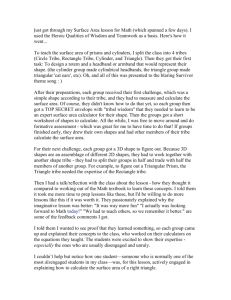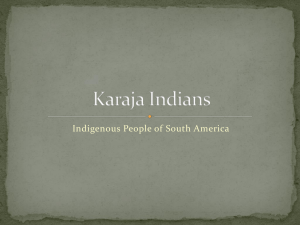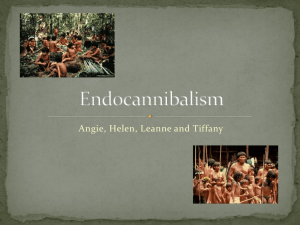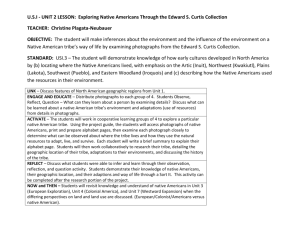5th Grade Project Sample (Traditional vs. Personalized)
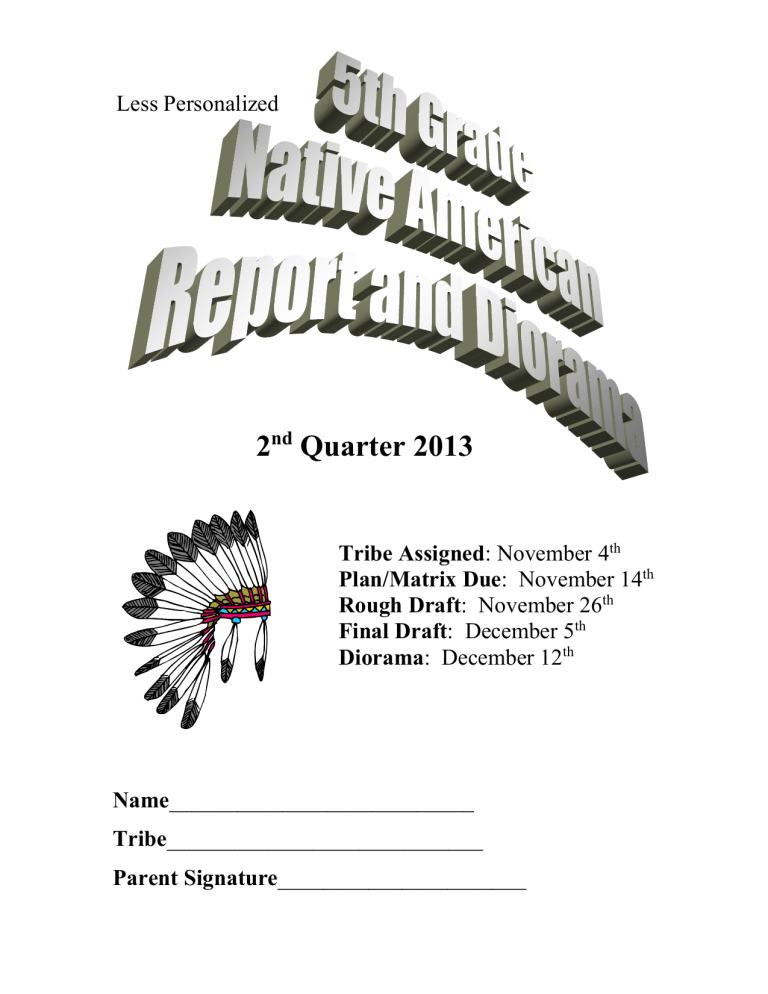
Less Personalized
2 nd Quarter 2013
Tribe Assigned : November 4
th
Plan/Matrix Due : November 14
th
Rough Draft : November 26
th
Final Draft : December 5
th
Diorama : December 12
th
Name ___________________________
Tribe ____________________________
Parent Signature ______________________
In order to meet Colorado State Standards in Social Studies, fifth graders will be required to conduct research and complete a report and diorama on Native Americans. This is a five-week project and will be graded on content and the writing process. Students will be given time in class to take notes from resources in the Media
Center and online, but books will be used only in the library and cannot be checked out because all fifth graders will be using them.
Students may check books out of the public library to supplement their resources if they feel they do not have enough time in class to complete their research. In addition, students will be given time in the computer lab to conduct research and gather information. This project is designed to be a student project. Students are welcome to ask family members and friends for help in the form of guidance and gathering materials, but students must complete the research, writing, or word-processing, and dioramas themselves.
Students will follow the process below to complete their reports:
1.
Researching – Decide what kinds of resources to use and where to find the information they need.
2.
Notetaking/Bibliography – Students will take notes from resources they use, including resources they print from online at home.
3.
Writing Process – Students will follow these steps to write their reports: a.
Plan - This can be a matrix, web, outline, or list. b.
Rough Draft – This can be word-processed or written by hand. c.
Edit – This will be in a pen or pencil of a different color. d.
Final copy – This will be word-processed or written in black ink, double-spaced, using the pages provided.
4.
Presenting – Students will present information to the class about the diorama.
All reports must have:
Page 1
Cover page
: This page should include the title of the report, the student’s name, the due date, teacher’s name, and should have a meaningful handdrawn illustration in color.
Page 2
Research report : This report must be word-processed, double-spaced, in font size
12 or 14, or written neatly in black ink. The backs of the pages should remain blank. Time will not be given in the computer lab to word process. The report must be a minimum of 5 paragraphs with at least 5-7 sentences in each. Each paragraph in the report should have a topic sentence and supporting details. The report should have a conclusion at the end that summarizes the entire report.
Ideas for topics to cover :
Introduction with who, what, where, when
Description of people, clothing; daily lives of men, women, children, in the tribe
Description of landforms and homes
Religious beliefs or cultural ceremonies
Allies and enemies or close-by tribes; history of the tribe
The tribe in 2011, who, what, when, where
Page 3 (optional)
Map : An appropriate map showing where the tribe lived may be included.
Last Page:
Sources
Students must list at least three sources for information on a bibliography sheet provided by the teacher. There must be at least one source from a book, one source from the web, and one source from a reference material. The title and author for each source should be listed on this page. Suggestions for sources are: books, encyclopedias, internet web sites, online encyclopedias, magazines, or interviews with Native Americans.
Three-dimensional Diorama
Students will need to construct a diorama with a replica of the dwelling of their Native American tribe. The diorama should be in a normal shoebox size container (no larger than 15” x 20”). The diorama should include the dwelling and background artwork that indicates the student researched the tribe and attempted to replicate the tribe’s dwelling and surroundings. Dioramas will be put on display so expensive or special items should not be included unless the diorama is totally enclosed. The diorama should be labeled with a 3” x 5” index card that gives the names of the tribe, student, and teacher.
Students will give an oral presentation that briefly tells where the tribe lived and about the dwelling. This presentation has a three-minute time limit, and will be part of the diorama grade. Students may use note cards for the presentation.
WHAT TO TURN IN
1.
Plan/matrix:
Due 11/14
2.
Rough draft, edited in a pen or pencil of a different color:
Due 11/26
3.
Final copy of report with cover page and bibliography:
Due 12/5
4.
Diorama:
Due 12/12
More Personalized:
Learning Target: I can create and present a detailed description of the attributes of at least one North American Native Tribe for a variety of audiences.
Colorado Academic Standards Addressed:
Social Studies:
1.1b - Examine significant historical documents. Topics to include but not limited to the Stamp Act, the Declaration of Independence, and the
Constitution (DOK 1)
1.1d - Analyze cartoons, artifacts, artwork, charts, and graphs related to eras and themes in North America from 1491 through the American
Revolution (DOK 1-3)
1.2a - Identify and explain cultural interactions between 1491 and the
American Revolution. Topics to include but not limited to the Columbian
Exchange, the interactions between Europeans and native Americans in the 17th and 18th centuries, and the developing relationship between
Europeans and enslaved Africans (DOK 1-2)
1.2b - Identify and describe the significant individuals and groups of
Native Americans and European colonists before the American
Revolution (DOK 1-2)
2.1b - Use geographic tools to identify, locate, and describe places and regions in the United States and suggest reasons for their location (DOK
1-3)
2.1c - Use geographic tools to identify, locate, and describe places and regions in the United States and suggest reasons for their location (DOK
1-3)
2.2a - Identify variables associated with discovery, exploration, and migration (DOK 1-2)
2.2b - Explain migration, trade, and cultural patterns that result from interactions (DOK 1-2)
2.2d - Analyze how cooperation and conflict among people contribute to political, economic, and social divisions in the United States (DOK 2-3)
Reading, Writing, Communicating:
1.1 - Effective communication requires speakers to express an opinion, provide information, describe a process, and persuade an audience
1.2 - Listening strategies are techniques that contribute to understanding different situations and serving different purposes
2.1 - Literary texts are understood and interpreted using a range of strategies
2.2 - Ideas found in a variety of informational texts need to be compared and understood
3.1 - The recursive writing process contributes to the creative and unique literary genres for a variety of audiences and purposes
3.2 - The recursive writing process creates stronger informational and persuasive texts for a variety of audiences and purposes
4.1 - High-quality research requires information that is organized and presented with documentation
4.2 - Identifying and evaluating concepts and ideas have implications
and consequences
4.3 - Quality reasoning requires asking questions and analyzing and evaluating viewpoints
Choose from one of the two scenarios below:
Scenario 1: The Denver Museum of Nature and Science has asked you to develop a new display for their North American Indian Cultures exhibit . Create an exciting and educational display that students from all over the World could use to learn more about the Native American tribe that you choose.
OR
Scenario 2: You are an advisor for settlers moving out of the established colonies in
1767. One of the many hardships families face when heading into the wilderness is how they will fit in with the surrounding Native American tribes. Develop a guide for a family on how to best recognize and work with the tribe they will encounter.
Checkpoints:
11/14/2013 – Peer Project Pitch
Present which scenario you chose
An outline of ideas for your work
Listen to feedback and questions about your pitch
Provide feedback about other’s pitch
11/26/2013 – Adult Project Pitch
Present your progress to an adult (teacher, principal, community member)
Listen to feedback and questions about your pitch
Develop timeline for any unfinished work
12/5/2013 – Small Group Peer Presentation
Practice run through your entire presentation
Listen to feedback and questions about your presentation
Identify areas to improve for final presentation
12/12/2013 – Final Presentation of Work
Be prepared with a short (1 – 2 minutes) introduction of your work
Be prepared to answer questions that come from those viewing your work
Choices:
Scenario:
1 or 2
How you work:
Individually or Collaboratively
Tribe (Choose at least one):
Apache
Cherokee
Hopi
Kiowa
Mohawk
Oneida
Shawnee
Teton Sioux
Arapaho
Cheyenne
Huron
Kwakiutl
Navajo
Powhatan
Shoshone
Zuni
Aztec
Comanche
Incas
Lenape
Nez Perce
Santee Sioux
Sioux
Possible Resources:
Media Center
Online resources o World Book Online o Discovery Streaming o The Denver Museum of Nature and Science o The Library of Congress online o Google Earth o Others?
Humans o Teacher o Art Teacher o LTE/TLC o Principals o Native Americans o Others?
Other Resources?
What we will teach:
Introduction to possible presentation and research tools
Tools and strategies for working in collaborative groups
Peer review techniques and protocols
How to research and take notes
How to cite your work
How to identify and communicate with appropriate human resources
Understanding the rubric
Blackfoot
Creek
Iroquois
Maya
Ojibwa
Seminole
Utes
Quality
Fifth Grade Native American Project Rubric
Yes, I Have it! (5) Where are you on the continuum between “Yes, I Have it!” (5) and “Not yet!” (1)
Ambiguity - I’m OK with a little confusion, knowing there is more than one
I don’t need to ask the teacher a lot of questions. I can think for myself and get the
5 4 3 2 1
Not yet! (1)
I have to be told exactly how to do every job. There is only one right way to do the job.
Inquisitiveness - I ask questions and want answers.
I am curious and I look up things that interest me. I’m a lifelong learner.
5 4 3 2 1
I don’t ask questions just for the joy of learning, and I don’t really want to learn new things.
Generating Ideas
(brainstorming) - I create lots of possible ideas.
I am able to fluently create a list of ideas. I use my imagination.
5 4 3 2 1
Originality of Ideas -
I create unique ideas!
I can think outside the box and I have a great imagination. I think of ideas that others never even thought of.
5 4 3 2 1
5 4 3 2 1
I cannot see beyond the obvious ideas. I am easily frustrated. I rarely use my imagination.
I can only think of ideas that others thought of first. I don’t like new ways of doing things. I just want to stick with the old way.
I am not willing to change my ideas or think of better ones.
Flexibility/
Adaptability -
Mentally, I can bend easily any which way and not break.
I can think of new ways to do things when I get stuck. I can recognize other people’s good ideas.
Self-Reflection - I can look honestly at myself and evaluate my work.
I can honestly go through my work and know what’s right or wrong.
5 4 3 2 1
I can’t or won’t look honestly at the things
I do well and the things that need more work.
Intrinsic Motivation
- I want to do it. I know the purpose and it pleases me.
I want to try new things. I believe in myself.
Risk Taking - I’m not afraid to try something difficult for fear of failure. As
Edison said: “I have not failed...I have succeeded in proving that 1000 ways will not work.”
I’m not afraid to try anything even if I don’t do well at it. I keep trying and find a new way that might work.
Expertise - I am proud and thankful to know a lot about one or more subjects. I am an expert.
I know I am good at one or more things, and I am not afraid to share my knowledge with others.
Persistence – I can stick with a project even when it gets hard. I understand that the word passion comes from the base word for “suffering.”
When the going gets tough, I work harder.
I have grit, determination, and perseverance. I want to keep going and finish a difficult task.
Presentation - I can present my findings in an interesting and engaging way.
My presentation is original, interesting, and exciting for others to participate in.
Research - I can collect relevant information to my topic.
Checkpoints – meet deadlines.
I can
My research is factual and in my own words. All sources have been cited.
My work is ready to present at each checkpoint.
5 4 3 2 1
5 4 3 2 1
5 4 3 2 1
5 4 3 2 1
5 4 3 2 1
5 4 3 2 1
5 4 3 2 1
Not willing to try new things unless I get something for it.
I don’t try new things for fear of failing. I try a couple times and give up altogether.
I don’t try to be expert at anything. I don’t want to be. Or I pretend to not know anything.
I usually quit when I run into a snag. I switch projects often whenever it gets too hard.
I don’t present my findings or my presentation is boring and not engaging.
My research is not accurate or simply copied from a source. Sources are not cited.
I am unprepared for the checkpoints.



